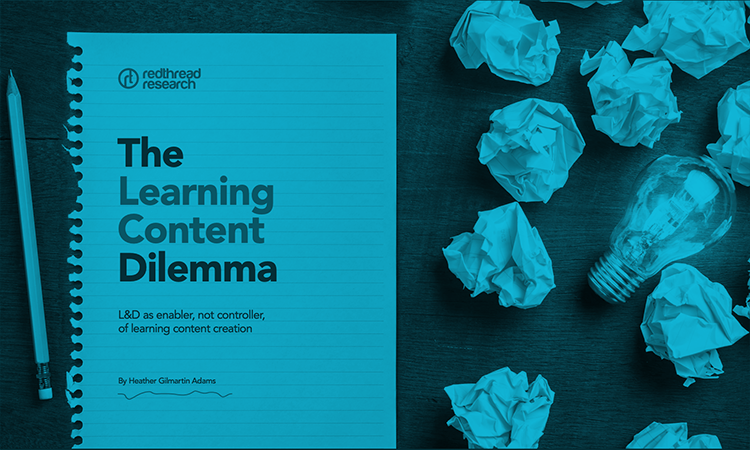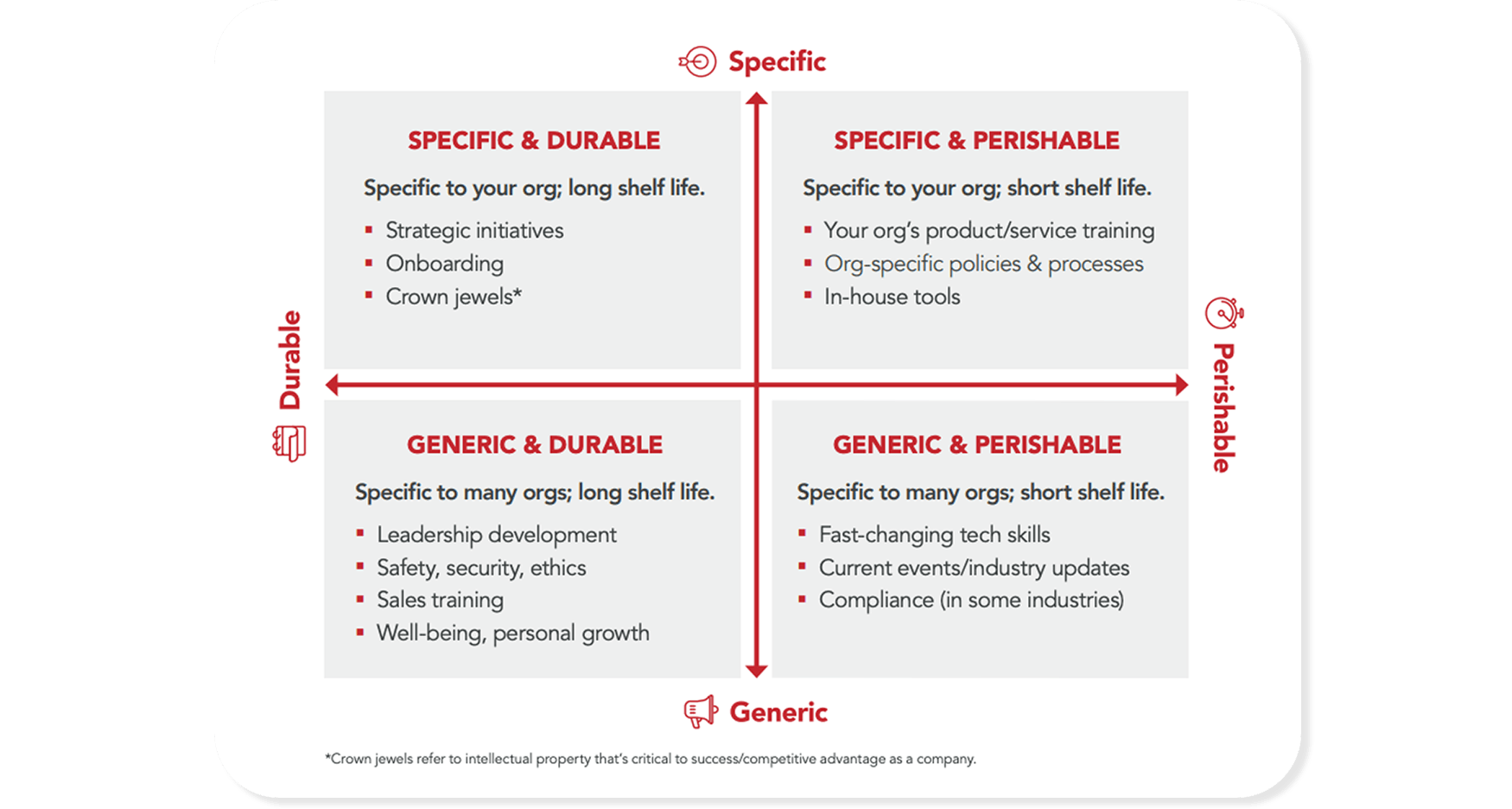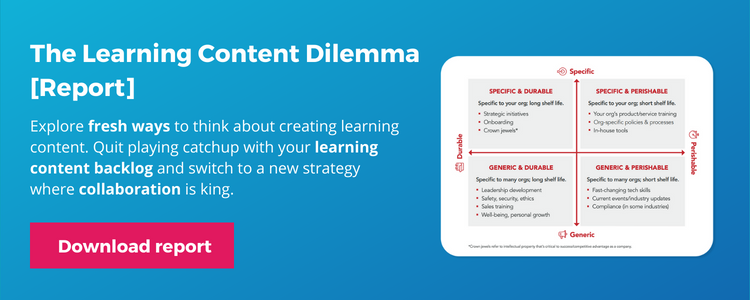A new research-led model for learning content
7 minute read
With the demand for impactful learning content at an all-time high, how can Learning & Development (L&D) teams adapt their approach to provide the right learning, at the right time, for all employees? Research says, L&D doesn’t have to do it all (phew!). This article pulls out key excerpts from a recent report that presents a new model for learning content, which helps learning teams increase capacity by putting content needs in perspective, and embracing collaboration.

The learning content dilemma
The amount of content needed to support organizational learning and business strategies has reached unmanageable levels. Under pressure to do more with less, L&D teams are stuck playing catch-up with an ever-increasing backlog of learning content.
This isn’t sustainable!
A new mindset is needed to meet the rise in demand and tackle the learning backlog – you’ll be glad to hear that L&D doesn’t have to do it all.
But if L&D isn’t doing it all, who’s helping? And is what they produce good enough?
This thinking is taken from the new RedThread research paper, Addressing the Content Dilemma, which was discussed by an expert panel of learning experts and global learning leaders, where they highlighted that internal experts are the key.
Jon Thompson, Director of Learning Experience & Innovation at The Coca-Cola Company shared:
“A lot of the times L&D organizations have been trimmed, downsized, right sized or re-chassised. Ultimately, it means we’re not as staffed out as we used to be. So, how do you still accomplish your goals?…There’s no way that we’re going to be able to provide all of the content to fill that space. There’s no way you’re going to get around having to ask others to lean in.”
A model for learning content (2 key dimensions)
When RedThread Research examined learning leaders’ approaches to learning content, they noticed 2 important dimensions of the learning content they work with:
- Specificity: How unique the learning content is to their organization.
- Durability: The shelf life of the learning content.
Plotting learning against those 2 dimensions revealed a model of 4 different kinds of content:
- Specific & Durable: Unique to one organization and has a long shelf life.
- Specific & Perishable: Unique to one organization but changes often.
- Generic & Perishable: Applies to many organizations and changes often.
- Generic & Durable: Applies to many organizations and has a long shelf life.

Learning leaders can use this model to clarify focus areas and roles around learning content. They can also make decisions about what content needs to be controlled or owned by the L&D function, and what can be outsourced or crowdsourced from within the organization.
L&D teams at full capacity need a new mindset to meet the rise in demand and upsurge in calls for skills. Mostly, a shift towards working more collaboratively, and letting internal experts in on production.
The main areas internal experts can support on? Those top two quadrants in the model: content that’s specific to your organization. Let’s take a closer look.
Learning content that appears in this category is often specific to your organization, but tends to have a shorter shelf life or needs updating frequently. This includes learning content related to your organization’s product or service training, company policies & processes, or training on in-house tools.
L&D’s focus for this quadrant should be to enable the creation and curation of learning content within the organization—not to create or control learning content. As this content comes from all over the organization it makes it difficult (if not impossible) for L&D functions to create and update it all.
Jon Thompson, Director of Learning Experience & Innovation at The Coca-Cola Company, shares his experience in the role of L&D:
“People are very much used to finding the answer quickly. And so it comes down to. How do you enable things with guardrails? With systems and rules that are frameworks that help shape the creation of content in a way that it makes it searchable and locatable and findable and relevant.
Challenges faced by L&D
Because this content needs to be updated frequently and can usually only be updated internally, it comes with 3 major challenges:
- Learning content becomes stale. Updating and maintaining all the learning content in an organization can be a monumental challenge.
- Content is decentralized. The best learning content exists in lots of different places. Sometimes it’s hard for employees to find the most relevant, impactful content for their needs.
- Quality and consistency of learning content can vary. Because it isn’t created by the L&D function, things like quality and branding of learning content can be inconsistent.
Opportunities for action
To address these challenges, learning leaders are implementing processes and guidance that enable anyone in the organization to create content with ease, that is consistent, and of high quality.
Here are the suggested actions off the back of the report from RedThread:
Do now:
- Implementing basic instructional design templates. (Learn more about elearning templates here)
- Putting in place tech that standardizes templates, design principles, and formatting (like Elucidat!).
- Being available as consultants—answering questions and providing advice on effective learning content that meets standards. (Learn more about how Elucidat’s Learning Consultancy can help you with this)
Work on:
- Improving curation by tracking usage and establishing ratings or rankings.
- Identifying, leveraging, and highlighting single sources of truth.
- Implementing systems and processes to encourage a culture of knowledge-sharing.
Also on our expert panel, David Hepworth, Learning Technology & Design Lead at Aviva, shared some insight on how his team helps the organization to create content:
“We’ve got a licence to create. So, you’ve got to do a little bit of learning and demonstrate some confidence which then opens up access to asset libraries, templates, rapid authoring…Because they know what they know. We just need to give them the framework to impart that knowledge.”
Hear more from David Hepworth on embedding democratized learning creation in this podcast episode.
Key category #2: Specific & Durable
Content in this category is unique to your organization, and often has a long shelf life. This may include learning content related to strategic initiatives, onboarding, and what RedThread terms your ‘crown jewels’. Content that is your USP, and gives you a competitive advantage and is therefore critical to the success of the business.
Heather Gilmartin Adams, Senior Analyst at RedThread Research and creator of the model, highlights this is a key focus for L&D.
“In the top left the last quadrant [of the matrix] is content that’s specific to your organization, but relatively durable…This is where L&D’s focus comes in: helping organizational initiatives and aligning learning content with organizational goals. This might be the category of content that would be most useful for L&D to focus their time and energy on actual content creation.”
Listen to Heather discussing the learning content dilemma in more detail in this podcast episode.
Challenges faced by L&D
As this links directly to key business initiatives, L&D functions typically face challenges like:
- Staying aligned with business goals. How can L&D stay agile in a changing environment?
- Driving change. How can learning content move the organization toward its goals?
- Measuring impact. How do we know if learning content is moving the needle in ways that align with the organization’s priorities?
Addressing these challenges, particularly around measuring impact, entails intentionally linking learning content to organizational priorities.
Opportunities for action
Here are the suggested actions off the back of the report from RedThread:
Do now:
- Make a plan for staying informed about organizational priorities and goals.
- Audit and align learning content with organizational initiatives.
- Implement marketing practices to increase awareness of content. (Learn how to Think like a marketer to drive L&D impact)
Work on:
- Collecting data and creating metrics to measure learning content against organization initiatives over time.
- Using stories and tapping into people’s emotions to make content stick.
David Hepworth, Learning Technology & Design Lead at Aviva, shared what’s working for his team:
“Simply by focusing our energy on the top left corner with our finite resources…we’re more aligned to the strategy. It means we’re more likely to get those skill identifiers right because we’re talking to business leaders about challenges they’re facing, and we’re probably talking about indicative measures or KPIs that are evidencing that there is an issue.”
We would add that the top left quadrant works best for really tight partnerships with business units, and subject experts. It’s also one where L&D professionals need to lead with a proactive consultative approach.
On the other hand, the top right quadrant is more about providing in-house experts with the tools they need to succeed. This quadrant needs close collaboration with subject experts, including needs analysis discussions, conversations, or templates to draw out stories and examples – but with L&D owning the design of the end solutions.
Summary
To meet the demand for high-quality digital learning many L&D teams are taking the steps to leverage more decentralized practices to enable collaborative content creation. Empowering your internal experts to create content doesn’t just tackle your training backlog, it will also help you meet your business needs with the right skills now and in the future.
RedThread’s learning content model helps put your content needs into perspective and suggests that empowering your people is the route to success. Want to learn more about how to empower others to create content or to digest the framework further?
Ready to dive into the full research report? Download your copy to unlock a new model for learning content production.




